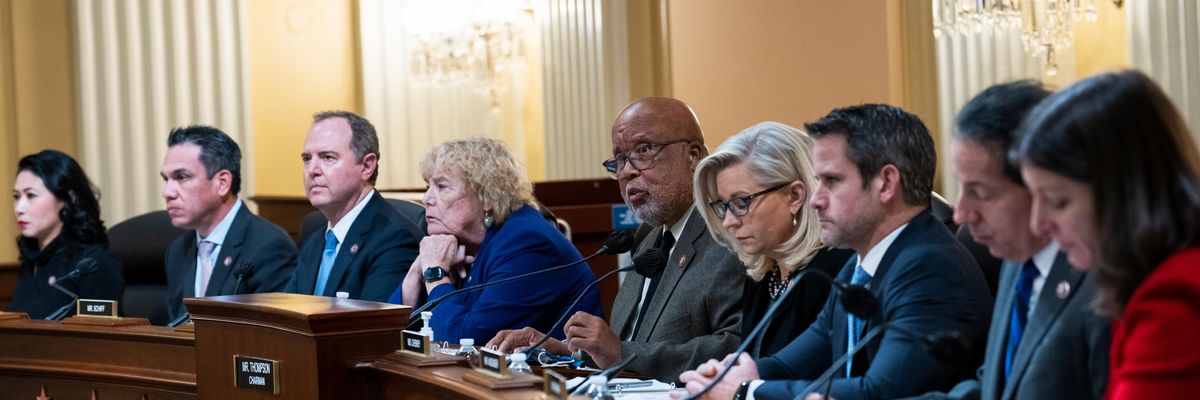

SUBSCRIBE TO OUR FREE NEWSLETTER
Daily news & progressive opinion—funded by the people, not the corporations—delivered straight to your inbox.
5
#000000
#FFFFFF
To donate by check, phone, or other method, see our More Ways to Give page.


Daily news & progressive opinion—funded by the people, not the corporations—delivered straight to your inbox.

Members of the House January 6th Committee--from L to R; Reps. Stephanie Murphy (D-Fla.), Pete Aguilar (D-Calif.), Adam Schiff (D-Calif.), Zoe Lofgren (D-Calif.), Chair Bennie Thompson (D-Miss.), Liz Cheney (R-Wyo.), Adam Kinzinger (R-Ill.), Jamie Raskin (D-Md.), and Elaine Luria (D-Va.)--are seen in this December 1, 2021 photo. (Photo: Tom Williams/CQ-Roll Call, Inc. via Getty Images)
The House select committee's January 6 hearings have so far exceeded all of our expectations. They have told the American people a gripping story of Trump's attempted coup--one packed with new details that seem to have swayed public opinion.
The content of the January 6 hearings may be even more important than the ones on Watergate, because the focus today strikes at the heart of our democracy: the peaceful transfer of power based upon the vote of the people.
Trump and Musk are on an unconstitutional rampage, aiming for virtually every corner of the federal government. These two right-wing billionaires are targeting nurses, scientists, teachers, daycare providers, judges, veterans, air traffic controllers, and nuclear safety inspectors. No one is safe. The food stamps program, Social Security, Medicare, and Medicaid are next. It’s an unprecedented disaster and a five-alarm fire, but there will be a reckoning. The people did not vote for this. The American people do not want this dystopian hellscape that hides behind claims of “efficiency.” Still, in reality, it is all a giveaway to corporate interests and the libertarian dreams of far-right oligarchs like Musk. Common Dreams is playing a vital role by reporting day and night on this orgy of corruption and greed, as well as what everyday people can do to organize and fight back. As a people-powered nonprofit news outlet, we cover issues the corporate media never will, but we can only continue with our readers’ support. |
The House select committee's January 6 hearings have so far exceeded all of our expectations. They have told the American people a gripping story of Trump's attempted coup--one packed with new details that seem to have swayed public opinion.
The content of the January 6 hearings may be even more important than the ones on Watergate, because the focus today strikes at the heart of our democracy: the peaceful transfer of power based upon the vote of the people.
The House select committee's January 6 hearings have so far exceeded all of our expectations. They have told the American people a gripping story of Trump's attempted coup--one packed with new details that seem to have swayed public opinion.
The content of the January 6 hearings may be even more important than the ones on Watergate, because the focus today strikes at the heart of our democracy: the peaceful transfer of power based upon the vote of the people.